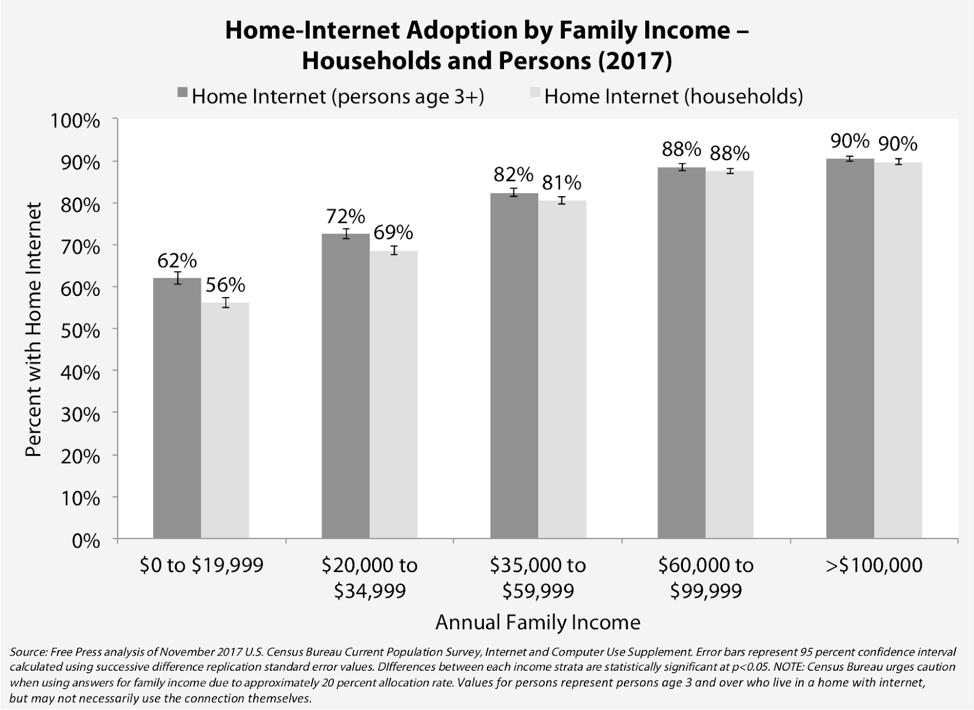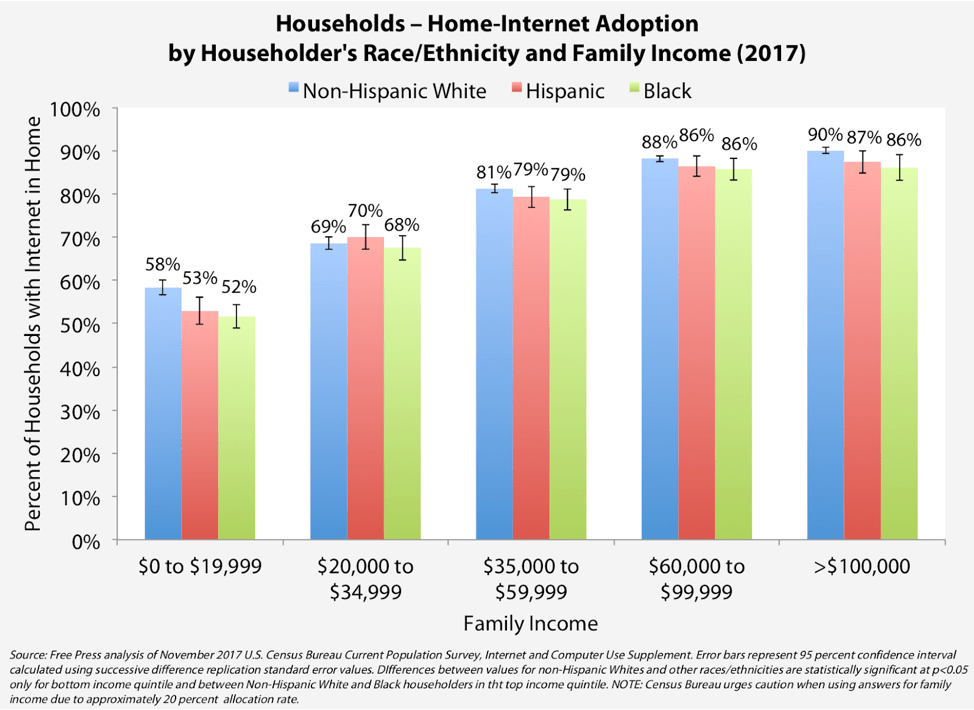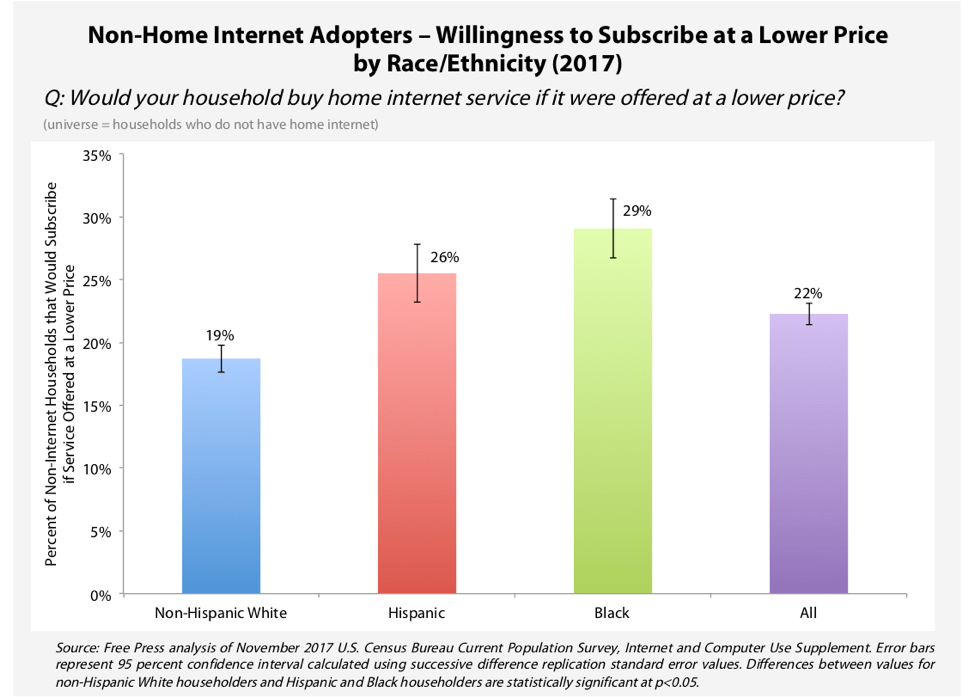The Truth About the Digital Divide

If the digital divide had one silver-bullet solution, we would have bridged it already.
At the outset of their recent Washington Post Op-Ed, Blair Levin and Larry Downes reject federal policymakers’ singular focus on promoting rural broadband deployment, arguing that the digital divide is not merely a question of rural access. In fact, they rightly note that there are more disconnected folks in urban areas than in rural ones. Millions of disconnected people live where broadband is already deployed, but still don’t subscribe to it.
However, the Op-Ed’s promise is dashed when the authors replicate the same kind of narrow-minded mistake they seek to correct. They insist that the only “real” solution to the digital divide is persuading disconnected people of the internet’s value — essentially trading one false silver bullet for another.
Affordability can’t be dismissed
Lack of interest certainly contributes to the digital divide, but it’s completely wrong to minimize the complexity of the broadband-adoption gap by suggesting that this is the only barrier.
To lift up their One Solution To Rule Them All, Levin and Downes callously proclaim the deployment divide insignificant and all but solved, and then say the affordability gap is no longer a factor — even though families stranded on the wrong side of the digital divide are disproportionately lower-income and people of color.
The dismissal of affordability concerns in particular is shallow at best.
Levin and Downes point to both the Lifeline program that subsidizes telecommunications services and discount internet offerings such as Comcast’s Internet Essentials as evidence of their bizarre conclusion that broadband is now affordable for all — but this ignores reality.
While Lifeline is absolutely vital to extremely poor families trying to get basic services, a $9.25 monthly subsidy is hardly sufficient to cover the costs of a high-quality broadband connection, especially in the wired market.
Similarly, Internet Essentials offers only 15 Mbps downstream to a limited pool of applicants (albeit less limited than it was at the outset of Comcast’s program). That’s a valuable choice for low-income people facing a duopoly market with few (if any) low-priced options, but not nearly robust enough to support the next-generation applications Levin and Downes tout as benefits to broader adoption.
“Relevance” is complicated
They further claim that while “early on,” non-adopters most frequently cited expensive prices as a reason not to subscribe to broadband, these numbers have since “declined rapidly,” with the majority of non-adopters now saying they simply don’t need broadband or that the internet just isn’t relevant to them.
This assertion is baffling across the board.
As far back as 2003, NTIA’s data suggested that non-adopters most frequently cited lack of need or interest as a reason for not subscribing. Yet citations of high prices have hardly declined, let alone rapidly — in 2003, 23 percent of non-adopters said high prices were the main barrier to subscribing, compared to 21 percent in 2017.
Not only do Levin and Downes overstate the “relevance” data and understate the affordability data, they willfully ignore the complexity of what relevance means to non-adopters.
Multiple studies have shown that claims of non-relevance are often tied to other barriers, including lack of affordability. When low-income non-adopters answered follow-up questions, one study found that “[f]or a significant portion of respondents, their lack of interest in using the Internet was rooted in the cost of the service, their lack of digital literacy, or their inability to obtain an affordable computer.”
There are in fact very few goods for which prices do not impact demand. Far from disproving the persistence of an affordability gap, the dominance of lack of “relevance” as a reason for non-adoption indicates that the digital divide is nuanced, with lack of affordability and digital-literacy barriers both playing key roles.
Levin and Downes strip away these intersecting factors and instead choose the least-nuanced and most patronizing interpretation of the data: that millions of non-adopters just don’t get why the internet matters.
They suggest that non-adopters aren’t “familiar with computing devices” — even though more people own devices than subscribe to home broadband, with 96 percent of U.S. adults owning a cellphone, and 81 percent owning a smartphone. They suggest that non-adopters don’t know what’s on the internet because they’ve never used it — even though Pew reports that 90 percent of U.S. adults use the internet, compared to only 73 percent who subscribe to home broadband.
The true story of the digital divide
The reality is that broadband adoption — particularly for wired service — is highly dependent on income and race. Poorer individuals and people of color are disproportionately more likely to be disconnected, and disproportionately more likely to adopt if there were more affordable services.
Census data show that low-income people are far less likely to adopt broadband than wealthier people, and that income is one of the strongest predictors of broadband adoption. Study after study after study has confirmed this income divide.

S. Derek Turner
Even among those with home internet, income and type of technology are closely related. Internet-adopting households in the bottom-income quintile are more than three times as likely as those in the top quintile to live in a home that has only mobile-phone internet access, which is typically cheaper and less robust than wired service.
In addition to that income gap is a distinct racial broadband-adoption gap, with people of color adopting home internet at lower rates than their white counterparts.
Much but not all of this divide stems from deeply rooted racial income inequality that leads to white people earning higher incomes than people who self-identify on the Census as Black and Hispanic. But Free Press research shows that the racial adoption gap persists even when we control for income, along with other demographic variables such as age, job and education. This means that even within income tiers, Black and Hispanic families are more likely than white families to be stranded on the wrong side of the digital divide.

S. Derek Turner
Levin and Downes would have us believe that disproportionate numbers of poor people and people of color don’t subscribe because they don’t understand the value of broadband — an assumption with racist and classist overtones that the data do not support.
Black and Hispanic households are more likely than white households to say they would buy home-internet service if it were offered at a lower price.

S. Derek Turner
These households are also more likely than white households to seek out internet access outside the home — for example, in libraries or retail locations — demonstrating an understanding and valuation of broadband service.
Poorer families are far more likely than wealthier households to cite high prices as a primary reason for not adopting, with nearly 25 percent of non-adopting households that make less than $20,000 a year calling price the most important barrier.
Promoting interest and digital literacy are important, but declaring the affordability divide “solved” doesn’t further digital-literacy goals. All it does is hurt people who need affordable options.
By reinforcing baseless stereotypes about low-income communities and people of color — and dismissing the persistent racial and economic gaps in broadband adoption — the authors’ false narrative does just what they rightly say an improper focus on rural deployment does. It actively directs resources away from possible policy solutions to bridge these gaps, and exclusively toward a narrowly defined prescription of marketing the digital world to non-adopters.
Low-income communities and communities of color by and large want internet service, but are prevented from adopting for a slate of complex reasons — including the fact that broadband prices are too damn high. That’s a serious injustice that denies millions of people the ability to pursue educational and economic opportunities, organize for justice and connect with loved ones.
It’s flat-out wrong to let this very real part of the digital divide be hand-waved away — and it risks exacerbating digital inequities even further.
It comes down to whose stories are lifted up, and whose are ignored. Certainly there are people who could easily and comfortably afford broadband, but don’t adopt because they don’t believe it’s “relevant.” Educating those people is a worthy goal — and a goal that many community-based organizations around the country are engaged in as they build digital literacy among the underserved.
But public policy — and the researchers who seek to guide it — should not be so dismissive of the millions of marginalized people who already do want to go online at home, but simply can’t afford it.